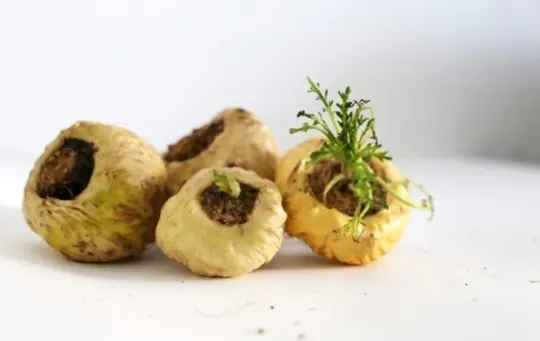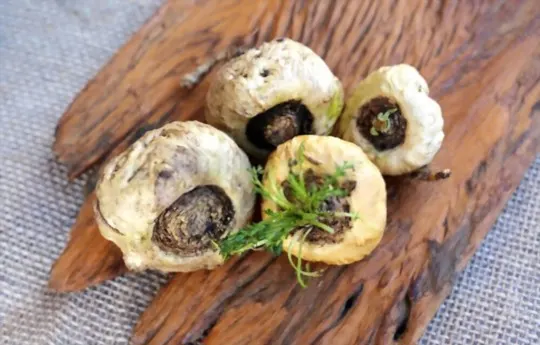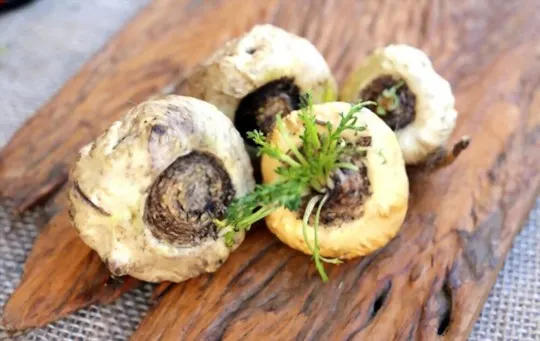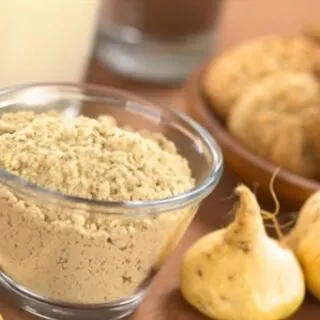Have you ever heard of maca before?
It’s not a widely known superfood, but it has been gaining popularity lately as more and more people are realizing the unique properties of this nutritious root vegetable.
But if you’re just learning about maca, one question that is likely on your mind is: what does maca taste like?
As you might imagine, there isn’t a singular answer to this question.
Many factors play into the flavor profile—especially when it comes to how much processing was done to the root itself.
In this article, we’ll dive deep into all these nuances so that by the time you finish reading through our comprehensive guide, you’ll have an accurate picture of just what kind of culinary experience awaits when adding maca powder or other forms of this beneficial vegetable addition to your diet!
What is Maca?

Maca is a root vegetable native to the Peruvian Andes that has been used since ancient times for its medicinal and nutritional benefits.
It has a distinctive flavor, with subtle sweet and nutty notes that are similar to butterscotch or hazelnuts.
Maca has long been valued for its energy-enhancing properties, as well as its ability to regulate hormones and improve mood and fertility.
It also contains minerals like iron, copper, potassium, zinc and calcium, as well as vitamins C and E.
Today, maca is used in many different forms – from powdered supplements to capsules and teas – to support overall wellbeing.
Whether you add it to your smoothies or use it to make tea, maca is a tasty way to get a daily dose of beneficial vitamins and minerals.
What Does Maca Taste Like?

Maca is a root vegetable native to Peru, known for its nutty flavor and perceived health benefits.
It is commonly enjoyed in powder form as a supplement or added to smoothies, oatmeal, or baked goods.
Maca has an earthy and nutty flavor, with a hint of sweetness.
Some people describe the taste as similar to butterscotch or caramel.
When consuming maca powder, it is recommended to start with a small amount and gradually increase the dosage.
Some people may experience mild digestive discomfort or side effects when first incorporating maca into their diet.
However, many users report feeling increased energy, improved mood, and enhanced libido as a result of regular consumption of maca.
Maca powder can be used as a caffeine-free alternative to coffee or tea in the morning or afternoon for a natural energy boost.
Factors that Affect the Taste of Maca
Maca is a root vegetable from the Andes that has been used for centuries for its perceived health benefits.
The taste of maca can vary depending on several factors.
- Soil: The soil in which maca is grown greatly affects its taste. Maca grown in fertile and healthy soil tends to have a more pleasant taste.
- Altitude: Maca grown at higher altitudes tends to have a sweeter, nuttier flavor, while those grown at lower altitudes may have a more bitter taste.
- Color: The color of maca can also affect its taste. Yellow maca tends to be sweeter, while red and black maca varieties have a stronger, more pungent taste.
- Processing: The way maca is processed can also impact its taste. Roasting maca can enhance its nutty flavor, while boiling it can make it taste earthier.
To fully enjoy the taste and benefits of maca, choose a high-quality source and experiment with different recipes to find your preferred way of consuming it.
1 – Color
Maca is a root vegetable that comes in a range of colors, each with their unique flavor profile.
The most common varieties have a cream-colored outer layer and yellow flesh, which has a subtle, nutty, and slightly sweet taste.
Some people describe the flavor as earthy and butterscotch-like, while others say it tastes like malt.
The darker-colored maca roots, such as black and red varieties, are more pungent and have a stronger flavor than the lighter varieties.
These roots have a slightly bitter taste that pairs well with chocolate, coffee, and other bold flavors.
Overall, the taste of maca is mild and versatile, making it a great addition to a range of dishes, including smoothies, baked goods, and savory dishes.
Pro tip: When using maca in recipes, start with a small amount and gradually increase the quantity to get the desired flavor.
2 – Preparation Method
Maca is a root vegetable from Peru that is packed with nutrients and has been used for centuries for its medicinal properties.
It has a slightly nutty and earthy flavor and can be used in a variety of dishes.
Here’s how to prepare maca:
- Start with raw maca root, which can be found in health food stores or online.
- Wash the maca root and chop it into small pieces.
- Spread the chopped maca on a baking sheet and roast in the oven at 300°F for 15-20 minutes, or until dry.
- Grind the roasted maca into a fine powder using a coffee grinder or food processor.
Maca powder can be added to smoothies, oatmeal, baked goods, and more for a boost of energy and nutrition.
It pairs well with chocolate, nuts, and warm spices like cinnamon and nutmeg.
3 – Quality
Maca is a root vegetable that has been used for centuries for its medicinal properties and is now known for its unique flavor that can be enjoyed in various ways.
Maca has a nutty and earthy flavor with a slightly sweet taste.
The taste can be described as a cross between caramel and butterscotch, making it a perfect ingredient for baking and adding flavor to drinks.
Maca can be consumed in several forms such as powder, capsule, or liquid extract.
The powder form is the most common and easiest to use.
To incorporate maca into your daily diet, you can add a teaspoon of maca powder into your smoothies, coffee, or baked goods.
Give this superfood a try and you might just discover a new favorite ingredient to spice up your meals.
Culinary Uses of Maca
Maca is a Peruvian root vegetable that has been used for centuries for its medicinal properties and culinary uses.
The taste of raw maca root is earthy, nutty, and slightly bitter, while powdered maca has a milder taste with nutty and caramel undertones.
Here are some popular culinary uses for maca:
- Smoothies and juices: Maca powder can be added to smoothies and juices to provide a boost of nutrients and energy.
- Baked goods: Maca powder can be used as a gluten-free substitute for flour in baked goods like bread, cookies, and cakes.
- Breakfast bowls: Maca powder can be added to oatmeal, granola, or yogurt bowls to add flavor and nutrition.
- Coffee and tea: Maca powder can be added to coffee or tea as a healthier alternative to sugar or cream.
- Soups and stews: Maca can be added to soups and stews to provide a unique flavor and nutritional benefits.
With its subtle, nutty taste and versatile uses, maca is a great addition to any kitchen.
Pro Tip: Experiment with different amounts of maca powder to find the right taste balance for you.
Is Maca Healthy?

Maca is a root vegetable that grows in the Andean mountains of Peru and Bolivia, and is often consumed for its potential health benefits.
It has a nutty and slightly sweet taste with a hint of butterscotch or caramel.
Maca can be consumed raw, cooked, or dried and ground into a powder.
Maca has been traditionally used to boost energy and stamina, improve fertility, alleviate menopause symptoms, and enhance mood and cognitive function.
However, there is limited scientific evidence to support these claims.
If you’re considering adding maca to your diet, it’s best to start with small doses and gradually increase the amount to avoid any potential side effects.
Pro tip – Adding maca powder to your smoothies or oatmeal is an easy and delicious way to incorporate this root vegetable into your diet.
Where to Buy Maca and How to Store It?

When it comes to buying maca, it is essential to consider factors like product quality, price, and sustainability.
Here are some popular places to buy maca and how to store it:
Where to Buy Maca:
- Health food stores: Look for high-quality maca powder or supplements in the supplement aisle of your local health food store.
- Online retailers: Many online retailers offer a wide selection of maca products.
- Farmers markets: You may also be able to find fresh or dried maca root at your local farmers market during the growing season.
How to Store Maca:
Store maca powder or supplements in a cool, dry place away from direct sunlight to prevent oxidation and preserve its nutrient content.
Bear in mind that the shelf life of maca can vary depending on the processing, so always check the expiry date before purchase.
What does maca taste like? Maca has an earthy, nutty, and slightly sweet flavor that is relatively mild and blends well with other foods and beverages.
Buy organic maca to ensure that it is free from any harmful additives and has a high nutritional profile.
Conclusion
In conclusion, Maca is a root vegetable from Peru that has been used for its medicinal properties and as a dietary supplement for centuries.
It has a nutty and earthy flavor profile that is rich and creamy, with hints of sweetness and bitterness.
Maca can be incorporated into a variety of dishes and beverages, including smoothies, baked goods, and energy bars.
Maca is available in different forms, including powder, capsules, and extract, and can be easily found in health food stores or online retail platforms.
Whether you are looking to improve your overall health or add depth to your culinary creations, maca is a versatile and nutritious ingredient that is worth exploring.

What Does Maca Taste Like? A Comprehensive Guide
Ingredients
- Maca
- Ingredients from your selected recipes
Instructions
- Select ingredients that work well together.
- Use a recipe or method that will enhance their natural taste.
- Taste and adjust the recipe as needed to achieve the desired flavor.

Carrie is a food writer and editor with more than 15 years of experience. She has worked for some of the biggest names in the food industry, including Bon Appétit, Food & Wine, and Martha Stewart Living.
As the Editor in Chief of IntroChicago.com, Carrie oversees all of the content on the site. She also manages the team of contributing writers and editors, who help to create delicious recipes, helpful tips, and informative articles that you’ll find on the site.
A native of the Chicago area, Carrie is passionate about all things food. She loves trying new restaurants and experimenting with new recipes in her kitchen. She’s also a graduate of the Culinary Institute of America, so she knows a thing or two about food!
